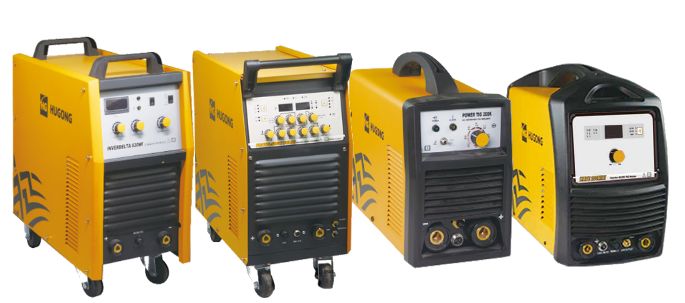TIG welding machines and their special functions

TIG welding machines and their special functions
In the world of professional TIG devices is one thing is rapidly becoming evident: high frequency ignition is a standard feature on all power sources. Direct current (DC), which transfers electrons from the negatively charged electrode (minus) to the positively charged workpiece (plus) is another common method of welding. Consequently, the majority of common materials may be joined with TIG DC (direct current) welding.
An whole different strategy is needed for the lightweight material and alternating current (AC) offers the answer. Although breaking up oxide coatings on the surface of aluminium requires temperatures above 2000 °C, there is an electrotechnical method that may be employed as a substitute: the workpiece and electrode always change polarity during TIG AC (alternating current) welding.
TIG welding on aluminum with alternating current
Electrons (charge carriers) will flow to the workpiece when the electrode is negatively charged. The charge carriers will move from the workpiece to the electrode when it is positively charged. It is also feasible to split the oxide layers because of this continual reversal of the electron flow between positive and negative charges.
TIG welding systems and reversed polarity ignition
Indeed. Due to the fact that the positive pole is usually stronger than the negative, reversed polarity ignition during DC welding is a major benefit. In a few of milliseconds, the electrode here obtains a positive polarity for arc beginning.
As a result, the tungsten electrode's temperature rises, guaranteeing perfectly steady and consistent arc ignition. A momentary polarity shift occurs during ignition, allowing for the use of a negatively charged electrode in DC mode for the balance of the welding operation. By doing this, damage to the electrode and overheating of the valuable tungsten are prevented.
RPI ignition in automated TIG welding
In particular, welding mistakes caused by insufficient ignition qualities can be avoided in robot-assisted and mechanised TIG applications, where there is no ongoing visual inspection of the weld metal, because of reversible firing.
TIG pulse welding
The power during TIG pulse welding fluctuates constantly, whereas the polarity (positive/negative) during AC welding varies in the form of a sine wave. It is possible to lessen heat input during the low current period by continuously mixing a greater pulse current with a low base current. This heat reduction opens even more doors for TIG pulsingthis process variant is ideal for mechanized pipe welding because the cool weld pool enables welding in any position.
Spot and stitch welding – combined with tacking
Whether it is a tacked seam or an individual tacking point, the stitch welding function operates in a similar way - the arc ignites, burns for the predetermined amount of time and then extinguishes. Unlike spot mode, though, there's a set pause period (two seconds, for instance) in between where the welding flame may be shifted to the subsequent tacking place. The arc ignites again, and the process begins over without the need to touch the torch trigger again. The torch trigger needs to be pulled again in order to finish stitch welding.
Stitch welding function
Turning on the tacking have first is usually advised when using either the spot or stitch welding modes. A secure connection is guaranteed by tack welding, especially if spot and stitch welding durations are kept to a minimum. Put otherwise, the tacking function may reduce the need for tacking and spot welding. Additionally, the tailored heat input lessens distortion.
High-tech-assisted TIG welding systems
There are many choices for alternating current, vibrating, tack welding, and other features have also been included with our TIG welding equipment at Weldarc. Over the last few decades, this has enabled us to increase our standards to the greatest practical certificate.

